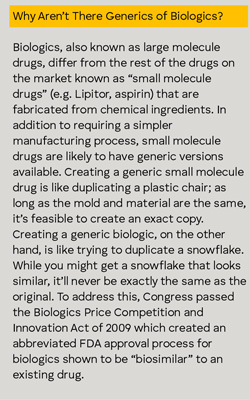
In 2015, the United States saw over $425 billion in pharmaceutical sales. Of that, biologics—drugs that are derived from a biological source, such as blood products, proteins, antibodies— accounted for around $75 billion. Due to the complexity of biologics and the difficulty related to manufacturing, they have had a monopoly in their indication area even after their patents expire. Although not identical, biosimilars must be highly similar to existing biologics, meaning no clinically meaningful differences can exist in order to achieve the biosimilar designation.

In the U.S., an estimated $54 billion worth of biologics will lose patent protection by 2019. Unsurprisingly, pharma sees this as an opportunity to snag market share. Companies are now faced with a new task—differentiating their biosimilars from current biologics and competitive biosimilars, which are clinically equivalent to current biologics. The healthcare industry sees biosimilars as a sea change in healthcare savings, due to increased market competition. Right now, the chief model of differentiation for generic pharmaceuticals is price. But if pharmaceutical companies market biosimilars solely on price, they’ll miss an opportunity to differentiate strategically from competitors, in a way generics never did.
Pharma companies want to expand their offering by differentiating beyond the drug. To do so, the offering must be compelling to patient and clinical stakeholders. At Continuum, we create compelling products, services, and experiences through user-centered design. The following are three major areas that will help pharma companies understand the key user experiences to help define how best to differentiate their biosimilars.
1. Understand the Patient Experience
Scroll through any blog or forum where patients discuss treating their illness with a biologic, and it becomes apparent that patients believe that these are miracle drugs. Doctors use biologics to treat a range of illnesses, from cancer to diabetes to immunological disorders. Given the wide range of diseases that biologics target, pharma companies must approach each drug within the context of the breadth of diseases and patient types for which the drug is efficacious. Those that do so will likely be able to develop new products and services that will make patients’ lives better. Improving the patient experience is more than making a patient feel comfortable; it is about ensuring adherence and drug efficacy for better outcomes and quality of life.
Compare the challenges of two patients: one living with a chronic, lifelong illness and the other facing a cancer diagnosis. Applying a user-centric design approach to identifying and understanding pain points will uncover different patient experiences. A chronic disease patient, depending on the specific disease, leads a lifestyle shaped by her chronic illness. She manages medications, understands physical limitations, and adapts her lifestyle accordingly. Her goals and expectations are likely focused on managing symptoms and improving quality of life. On the other hand, the person with cancer is coming to terms with his diagnosis and beginning treatment at the same time. His life is in upheaval: he must adjust to “being sick” and making regular treatments his new “normal.” His goals and expectations are about getting back to his old life. Addressing these two often very different patient experiences requires different approaches to developing truly differentiated products and services.
It’s also important to understand how the location of treatment impacts the patient experience. Major concerns around an at-home treatment are ensuring the patient properly stores and takes the medication to achieve the long term intended outcomes. A patient-centric solution may involve a smart auto-injector that mitigates these concerns. In a clinical setting, an example pain point is patient travel to the clinic. One novel solution a provider has implemented is its own transportation solution.
2. Understand the Pharmacy Experience
While the patient is, and should be, at the center of the biologic treatment ecosystem, there are other stakeholders to consider and to incorporate into the optimal patient experience. At clinics, where patients receive infusions of biologics, a key location is the pharmacy.
The pharmacist is a member of the healthcare team who directly interfaces with the patient. His focus is ensuring the safe and effective use of medication. However, many aspects of a pharmacist’s job are unrelated to direct patient care. One major aspect of a pharmacist’s responsibilities involves handling the drug budget. For most, drug waste creates a huge budgeting headache. There’s an opportunity for drug companies to intercede and apply user-centered design thinking and innovation to create novel solutions to this problem. Innovations in novel delivery devices or an enhanced service may address this systemic issue. To focus on this pain point is to provide a business case for pharma companies to justify a higher price point from competition.
The pharmacist experience is not the only experience in the pharmacy. Insights come from understanding the entire journey a drug makes within these establishments. The journey starts with a vial being taken out of the delivery box at the clinic and ends with it being infused into the patient. Along this journey, multiple pharmacy players interact with the drug. Understanding every step, including the handoffs of the drug and interactions between pharmacy players, unearths pain points and workarounds. These can provide inspiration for how to design a better product or experience for the pharmacy.
3. Understand the Physician Experience
When it comes to creating a treatment plan, the general direction and choices are made by a doctor. For many, treatment planning is more of an art than a science. Learning this art—the how and why of specific treatment paths doctors choose—reveals their goals, desires, and challenges when treating their patients. For instance, doctors must extrapolate clinical data to create a treatment plan that fits the needs of their patient. This is because patients in clinical studies are different than other patients. These patients meet specific criteria that others outside clinical studies may not meet. Due to this difference, pharmaceutical companies can’t assume doctors prescribe strictly according to clinical data. Removing that assumption means doctors take into account other factors when prescribing a treatment for a patient. These other factors may make treatment planning more complicated. Understanding these factors and their difficulties presents an opportunity to design products and services to make treatment planning easier.
Creating Vision
Recognizing and learning about the different user experiences is only the first step in implementing user-centered design. Designing for all of these experiences means not only working together but enhancing one another. Creating a user-centered vision takes an investment in constructing an ecosystem among the healthcare stakeholders. Doing so means building long-term differentiation and value.




